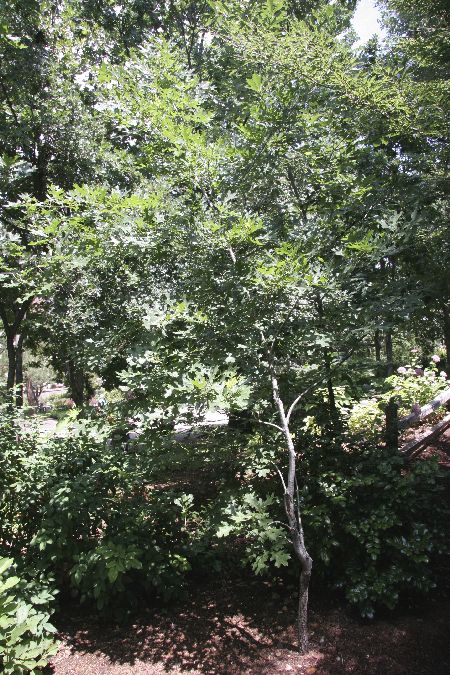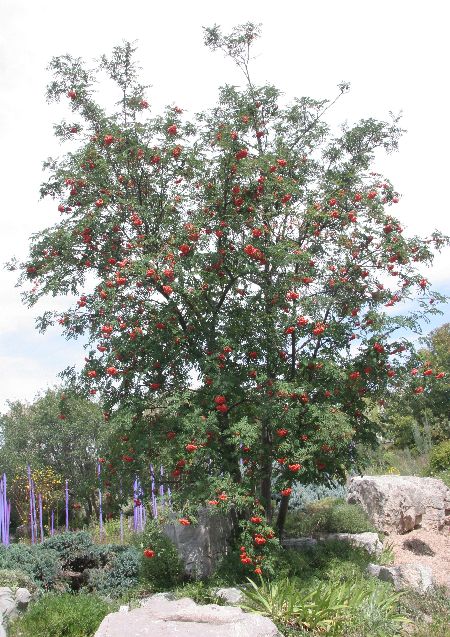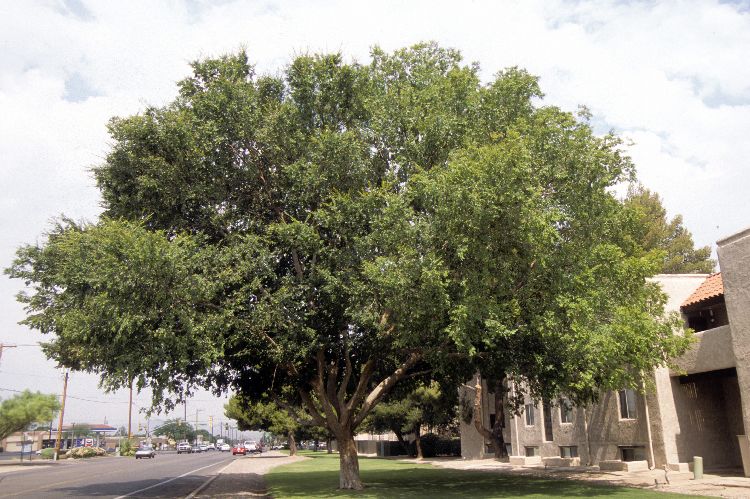Quercus gambellii
Gambel's Oak, Scrub Oak
Grow as a tree or shrub; low branching habit makes it ideal to form natural screens and thickets. Leaves (see photo) are deeply lobed, they turn brown or red in fall. Acorns attract birds and small mammals. Canopy coverage: 314 square feet.
[Read More]Quercus macrocarpa
Burr Oak, Mossycup Oak
Young Burr Oaks are pyramidal to oval in form, then eventually evolve into trees having a broad, rounded crown. Leaves are glossy dark green above, whitish beneath, which adds the element of movement when leaves move in the wind. Fall color is yellow and brown. Accepts most soils. Canopy coverage: 2,827 square feet.
[Read More]
Quercus muehlenbergii
Chinquapin Oak, Chestnut Oak
Chinquapin Oak is a tree for large open areas. Trees can be difficult to establish. Leaves turn gold in fall. Canopy coverage: 2,827 square feet.
[Read More]Rhus typhina
Staghorn Sumac
Staghorn Sumac is a large, spreading shrub that expands its territory by suckers, colonizing the surrounding area, so it is not the best choice for small, finite locations. New growth on branches is covered with dense fine hairs reminiscent of staghorns. Attractions include brilliant, red fall color, and red fruit that grow in upright, pyramidal clusters. Canopy coverage: 177 square feet.
[Read More]Rhus typhina 'Laciniata'
Cutleaf Staghorn Sumac
Cutleaf Staghorn Sumac is a tough-minded cultivar (cultivated variety) of Staghorn Sumac. As you would expect, leaves are finely dissected. Like the species new growth on branches is covered with dense fine hairs reminiscent of staghorns. It also produces brilliant, red and orange fall color, and red fruit that grow in upright, pyramidal clusters. Canopy coverage: 50 square feet.
[Read More]Robinia neomexicana
New Mexico Locust, Desert Locust
New Mexico Locust can be grown as a tree or shrub but most often a thicket-forming, spiny shrub, useful as a barrier or screen. Note that seeds are poisonous. Flowers are fragrant and are profuse in clusters. The interesting seed pods are dark brown, hairy, up to 4 inches long, and hang on branches for a long time. Canopy coverage: 113 square feet.
[Read More]Shepherdia argentea
Buffaloberry, Silverberry
Buffaloberry is a tough plant that meets the challenges of adverse conditions of extreme cold, winds and poor soils. Will accept little to regular water. A good wildlife habitat plant or security screen. Female plants produce small orange or red berries that are edible if a male plant is in the area. Canopy coverage: 113 square feet.
[Read More]Sorbus alnifolia
Korean Mountain Ash
The dense-growing branches of Korean Mountain Ash make this a good shade tree. Berries that follow spring flowers turn orange-red in the fall, attracting birds. Requires acid, well drained, loamy soil to grow them successfully. Canopy coverage: 314 square feet.
[Read More]
Sorbus aucuparia
European Mountain Ash
This is a top-of-the-list Mountain Ash, due to the varied interest it offers throughout the year: profuse flowers in spring, bright red berries and reddish fall color. Trees are upright when young then develop a spreading, open crown as they mature. Requires acid, well drained, loamy soil to grow them successfully. Canopy coverage: 314 square feet.
[Read More]Styphnolobium japonicum
Japanese Pagoda Tree
Japanese Pagoda Tree is an excellent shade tree with wide-spreading branches. Accepts sandy, clay and poor soils, as long as soil is well drained. Prefers moist soil. Accepts air pollution. Canopy coverage: 491 square feet.
[Read More]Syringa reticulata
Japanese Tree Lilac
As a tree form it has a rounded crown, or grow as a large shrub or hedge. Flowers are fragrant. Accepts minor shade but full sun is best. Canopy coverage: 314 square feet.
[Read More]Tilia cordata
Littleleaf Linden
Linden is known to be an excellent shade tree, with a dense, pyramidal form and large, almost heart-shaped leaves. Leaves are green above, silvery below, adding interest as they blow in the wind. Flowers are small but highly fragrant. Littleaf Linden is native to Europe, which are often preferred choices. 'Greenspire' is an improved selection. Accepts sandy to clay soils, if well drained. Canopy coverage: 1,963 square feet.
[Read More]Tilia tomentosa
Silver Linden
Form is a regal broad, compact and dense pyramid. Leaves are glossy green above, whitish below, which adds interest as they flutter in the wind. Heat and drought tolerant once established. Accepts sandy to clay soils, if well drained. Canopy coverage: 707 square feet.
[Read More]
Ulmus parvifolia
Evergreen Elm
Evergreen Elm is an extremely fast-growing tree for shade. Mottled tan and gray bark is an attraction. Thin—don't top—branches in crown to prevent wind damage. Canopy coverage: 962 square feet.
[Read More]Viburnum lentago
Nannyberry Viburnum
Grow Nannyberry Viburnum as a shrub or small tree. It produces upright growth with arching branches. Flowers bloom in flat-topped clusters that are followed by blue-black fruit in fall to early winter. Canopy coverage: 113 square feet.
[Read More]Viburnum rufidulum
Rusty Blackhaw Viburnum
A woodlands shrub or tree that can be used as a hedge, screen or natural border. If the edible fruit is a goal, plant multiple plants to help ensure pollination. Fall color in shades of reddish purple is an additional attraction. Canopy coverage: 177 square feet.
[Read More]Xanthoceras sorbifolium
Yellowhorn
A cold hardy tree or shrub with interesting flowers. They are white, fragrant, with red or yellow centers. Round to pear-shaped fruit follow. Canopy coverage: 491 square feet.
[Read More]